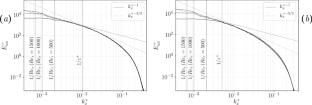Energy Cascade Phenomena in Temporal Boundary Layers
Abstract
The geometrically complex mechanisms of energy transfer in the compound space of scales and positions of wall turbulent flows are investigated in a temporally evolving boundary layer. The phenomena consist of spatially ascending reverse and forward cascades from the small production scales of the buffer layer to the small dissipative scales distributed among the entire boundary layer height. The observed qualitative behaviour conforms with previous results in turbulent channel flow, thus suggesting that the observed phenomenology is a robust statistical feature of wall turbulence in general. An interesting feature is the behaviour of energy transfer at the turbulent/non-turbulent interface, where forward energy cascade is found to be almost absent. In particular, the turbulent core is found to sustain a variety of large-scale wall-parallel motions at the turbulent interface through weak but persistent reverse energy cascades. This behaviour conforms with previous results in free shear flows, thus suggesting that the observed phenomenology is a robust statistical feature of turbulent shear flows featuring turbulent/non-turbulent interfaces in general.



 求助内容:
求助内容: 应助结果提醒方式:
应助结果提醒方式:


